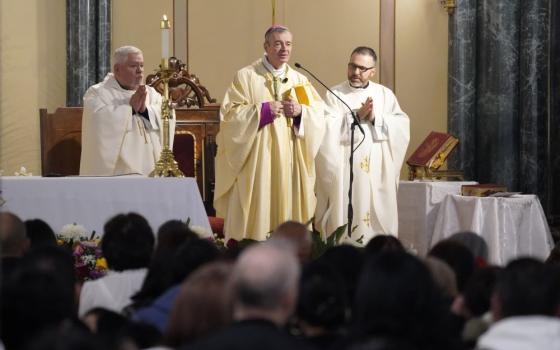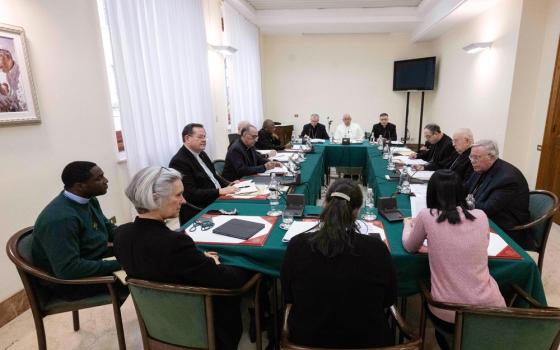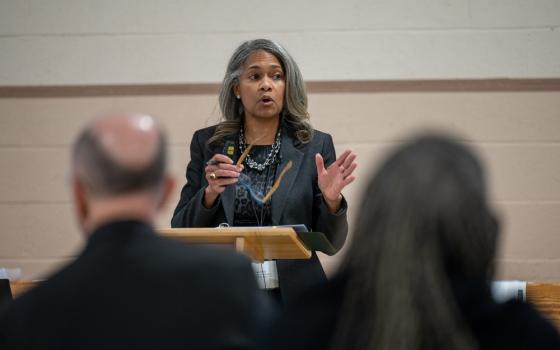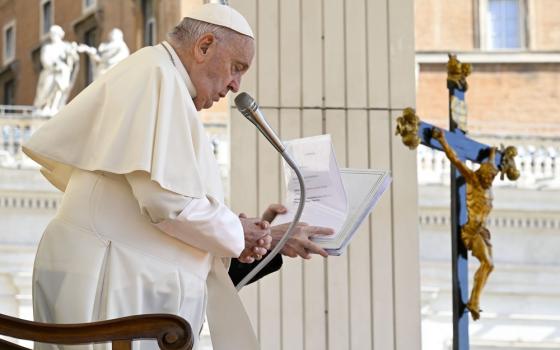By JOHN L. ALLEN JR.
Rome
Cardinal Roger Mahony of Los Angeles is one of two representatives of the American bishops in the Oct. 10-24 Synod of Bishops for the Middle East, along with Archbishop Allen Vigneron of Detroit. Mahony sits on the Congregation for Eastern Churches, and presides over what is arguably the most multi-cultural diocese in America, which includes outposts of all six of the Eastern Catholic churches of the Middle East: Armenian, Chaldean, Coptic, Maronite, Melkite, and Syrian Catholics.
Mahony is already anticipating his retirement in February 2011, with the transfer of power in Los Angeles to Archbishop Jose Gomez. Nonetheless, he remains vitally engaged in issues facing Catholicism in America, especially the case for immigration reform.
He sat down on Oct. 18 for an interview with NCR about the Synod of Bishops for the Middle East.
| Read NCR's full coverage of the Synod of Bishops for the Middle East: Index of stories from the Synod. |
What has struck you about the synod?
First of all, I’ve been struck by the coming together of all these leaders of the churches in all these major Middle Eastern countries. I’d kind of presumed that they met frequently, and I hadn’t realized that this was not normal. It was very refreshing, because I saw them listening to each other in a way that maybe they hadn’t before, and they realized that they have a lot more in common than perhaps they had thought. Historically, they thought of themselves as six distinct, different Eastern rite churches. I think that’s how they saw themselves … this is our patriarchate, these are our people, you other folks are maybe there somewhere historically, culturally, but that’s not us. I really felt that there’s been a good sense of looking at themselves together, for the first time, in a way they may not have before.
One interesting point is that some of the Latin rite bishops thought we all belonged to the one Roman Catholic church. As they listened to some of the bishops from the Eastern churches, they thought, wait a minute … you’re equating ‘Roman Catholic’ with ‘Latin rite.’ We see the Bishop of Rome as the head of the Roman Catholic church, therefore we’ve seen ourselves as brothers and sisters all along. That’s a keen insight. The question is, how do we plumb that for the good of our people?
One theme that has come out of the synod is the desire from the Eastern Catholic churches to be more visible, and better understood, among the majority Latin tradition in the Catholic church. Concretely, what do you think we can do to lift up the Eastern Catholic churches?
It’s interesting, because there are obviously two different perspectives. The people in the Middle East see themselves far differently than their counterparts in the United States, Australia, Canada, and Latin America. I found that fascinating. In our Archdiocese of Los Angeles, for example, we have all of the six Eastern rite churches of the Middle East, and most of the others (Eastern churches). We have a very good working relationship with them. For example, the Eastern rite churches in our archdiocese don’t see themselves as operating distinct from us. They see themselves as sister churches together. I don’t detect that from the folks in the Middle East … that is not their experience.
I’ve already said that when I get back, I’m having a luncheon for all the Eastern rite priests in the archdiocese, in early December, to talk about the synod and its results, in order to help our bonds grow closer.
The Eastern churches in Los Angeles feel integrated into the local church?
Yes, and they feel safe.
But how visible are they? For example, take the typical priest in Los Angeles: How many of the 22 Eastern rite churches in communion with Rome do you think he could name?
It depends on the Eastern rite, to be honest with you. Some of them make a great effort to go to deanery meetings, to participate in events in the archdiocese. They go to the Chrism Mass, and they go to the presbyteral days. They are well known and liked.
In general, are you in favor of trying to put more of a spotlight on the Eastern rite churches?
Yes, especially because in our archdiocese their numbers are growing. They’re opening more parishes. Their presence is being felt, in a very positive way. How they’re received often depends on whether they close themselves in, circle the wagons, or they take the steps available to them to relate to the other parishes and the Latin rite churches.
Certainly, there’s more we can do. Take our Religious Education Congress in Los Angeles – we don’t have an Eastern rite liturgy. We’ve got to give opportunities for larger numbers of people to come into this knowledge. In my own remarks at the synod, I said that our Catholic colleges and universities have all kinds of courses in Buddhism, Hinduism, you name it, but we have nothing that touches on the Eastern rite Catholics.
Beyond hand-wringing about the exodus of Christians from the Middle East, there is also a good news story about the influx of new Christians in the Middle East from Africa and Asia. Were you aware prior to the synod of the magnitude of this immigration of Christians into the region, mostly in the form of foreign workers?
Not the magnitude of it, no. I have a great relationship with our Filipino people, so I knew that many Filipinos were moving into the area to work in these countries. But I had no idea that it was in the millions. It’s coming from the Philippines, Southeast Asia, and Africa. The influx of these new Christians, many of whom are Catholics, far outweighs the emigration. That’s going to be a new fertile ground for the life of the church, and the vitality of the church.
There’s a case for hope for Christianity in the Middle East?
Absolutely, especially when you look at the birth rates in those countries. They will continue to need immigrants, and a large share of them will be Christians and Catholics.
What do you hope the synod might produce?
I’m hopeful the synod will give some measure of hope and confidence to the Christians living in the Middle East, especially those in the most difficult situations. As St. Paul puts it, we must give reasons for our hope. We have to give reasons why they’re important and need to stay there. Many of the synod fathers have spoken to that very eloquently, asking, ‘When have Christians ever been the majorities in these areas?’ From the time of Jesus, mostly we have been minorities, and have had to suffer and to give witness. We’re still doing that. We have to help people understand that historical connection, rooted in faith. We’re asking you to live the same witness as the people in St. Paul’s letters, the same witness.
Concretely, what can American Catholics do to be of support to Christians in the Middle East?
Let me move from the simple to the complex. First, we can make a pointed effort to support the Good Friday collection for the Holy Land. With all the dioceses involved, we have gone from about $300,000 total to $1.2 million. It’s because we have explained what this is about. It’s as simple as that.
I think we can do more with our mission cooperative appeal, in which our propagation of the faith offices invite certain people to come in to talk about what they’re doing. We’ve never really reached out to the Eastern rite churches, and we should do that. It’s a very good way to educate our people. Certainly the Knights and Ladies of the Holy Sepulcher have had a tremendous impact, because they’re keeping the parishes open, the schools open, the missions open, and the clinics open. So many of the schools are serving Muslims, Jews, and Christians in the same classroom, and nothing could be better than that experience. The Knights and Dames of Malta focus on the clinics, and on health care.
Mission Sunday is coming up, and I know that I never make a reference directly to the Middle East. But this is a part of the Mission Sunday collection. I think we have to continue to find these small ways that connect our people, directly and indirectly, to the Middle East.
What about pilgrimage?
It’s big. Last year, the Knights of the Holy Sepulcher in our region took 150 people on a pilgrimage. It was spectacular. I think pilgrimages give people a first-hand understanding of Jesus and the gospels, and it becomes real.
Would you agree that these pilgrimages should focus not just on the holy sites, but the living Christian communities of the Middle East?
Absolutely. It’s about preserving the Christian communities. I suspect that some forces in the region would love to see them become museums. That’s why we always want Christian guides, and the ones we had knew more scripture than most priests have forgotten. They were able to connect us with the life of Jesus in the gospels in a way that was just phenomenal.
Recently Monsignor Robert Stern of the Catholic Near East Welfare Association said that if American Catholics want to help Christians in the Middle East, one step would be to reach out to Muslims in the United States. The argument is that American Muslims might be able to lead global Islam towards a more pluralistic position. Do you agree?
I do. Most of the Muslims we deal with in the United States are not extremists on either side. They’re not the jihadists. They are the Muslims of the world. The more we give them influence and power, the better it will be for the entire world.




